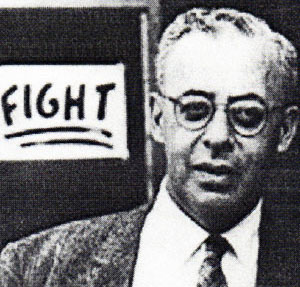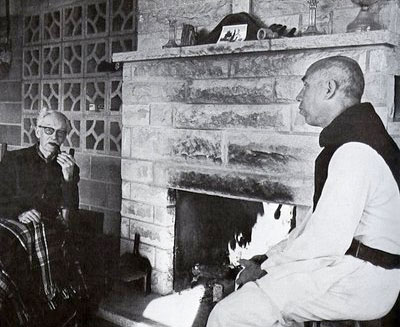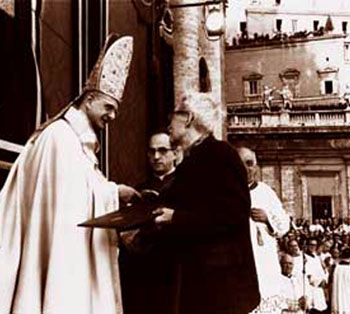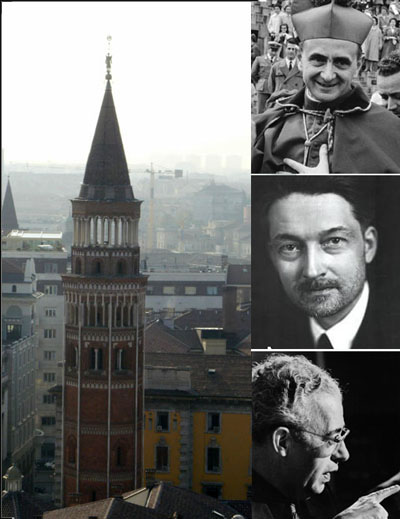 |
Traditionalist Issues
An Intriguing Scenario
Prof. Remi Amelunxen
There was a paradoxical relationship among three men, Saul David Alinsky, Jacques Maritain and the Archbishop of Milan Giovanni Battista Montini who became Paul VI. Before describing their interrelationship, a short biography of each of the three will be presented.
Alinsky, a radical Marxist

Alinsky, revolutionary to the core |
Saul David Alinsky, a Russian Jew, was born in 1909 and died in 1972. He was a dedicated Marxist who helped establish the political tactics of subversion that characterized the 1960s in this country.
In the Alinsky paradigm, organizing is a euphemism for revolution, with the objective that any “oppressed” group of the population should acquire power by radically transforming the social and economic structure of the U.S.
As a subtle revolutionary he avoided flaunting bloody radicalism, as set out in his infamous book Rules for Radicals. Instead, for the victory of Marxism he recommended infiltration of churches, unions and political parties to transform them from within. His aim was to ultimately crush the Establishment and install Socialism.
Maritain and his integral humanism
Jacques Maritain, a French Catholic philosopher, was born in in 1882 and died in 1973. He was a Protestant who became a Catholic in 1906 during his student days at the Sorbonne. From 1945 to 1948, he was the French Ambassador to the Vatican. His reputation to be a Thomist scholar and lectures at the Pontifical Institute of Medieval Studies enhanced his prestige and enabled him access to Pope Pius XII and his pro-Secretary of State, Msgr. Montini, with whom he often visited privately. In 1948 he returned to America to take a professorship at Princeton.
In 1936 Maritain expounded his liberal thinking in political philosophy in a book he titled Integral Humanism. In it he promotes a new Christendom rooted in a theocentric pluralism, informed by rights of man of the Enlightenment and conjoined to the philosophy of democracy. Creating this integral humanism would not be a matter of trying to establish the Kingdom of God on earth, Maritain tells us, but rather of making the world a “place of a truly and fully human earthly life.” (1)

In 1966 Maritain and Thomas Merton, the well-known progressivist Trappist monk |
In it he proposes that people of different religions and philosophies cooperate to achieve common good. Society would be governed by a pragmatic consensus, forged by members of a community, who supposedly transcend their religious or philosophical differences to live harmoniously together. (2)
He further developed this progressivist thinking in a second work Man and the State in 1951. In its final pages, he speculates on the possibility of a world government.
Maritain’s theories called for a basic shift in the way the Church looks at herself, i.e. her function and identity. Integral humanism, like the theories of the pantheist-evolutionist Fr. Teilhard de Chardin, sees every religion converging toward a single human ideal in a world civilization where all will be reconciled in peace, love and justice, which supposedly will lead all to a mysterious fulfillment of the Gospel.
In the integral humanism of Jacques Maritain, man enters a universal fraternity where the Catholic Church does not demand or even suggest that she is the one true Church. Maritains’ theory is a call for Catholics to set aside dogmatic differences with her enemies and achieve the desired unity throughout practical arrangements.
Maritain & Alinsky
From Pius XII onward, Maritain was praised and promoted by the Vatican. Paul VI’s enthusiasm for his theories was life-long. Maritain’s thinking on integral humanism and the rights of man spoke to the central concerns of Montini’s life and ministry.

Paul VI welcoming Maritain on the closing day of the Council |
Pope Paul VI readily admitted the profound influence of the French theologian’s thinking, and he even cited Maritain’s Integral Humanism in his Encyclical Populorum progressio. At the close of the Vatican Council II, the Pope's "Address to Men of Thought and Science" was dedicated to his dear friend and mentor.
Maritain’s thinking influenced many of the documents of Vatican II that dealt with human dignity, ecumenism and the relations between Church and State. Maritain's presentation on rights is the language of rights that Dignitatis humanae employs.
Many Catholics are unaware of the strong 30-year friendship between the progressivist philosopher Jacques Maritain and the Marxist agitator Saul Alinsky. They were “devoted friends” from their first meeting in 1940, visiting often and discussing issues of social justice. When Maritain was in Rome as ambassador, he sent Alinsky copies of all his articles and talks, and in return he reviewed Alinsky’s manuscript of Rules for Radicals.
In Alinsky’s organizations, Maritain found a near-perfect embodiment of the mediating structures he had called for in Integral Humanism. He also approved of Alinsky’s subversive methods as outlined in Rules for Radicals. (3)
Paul VI , a longtime admirer of Maritain
A short biography of Paul VI follows before we reach the intriguing scenario that involves the three men – Montini, Maritain and Alinsky. Giovanni Battista Martini was born in 1897 and died in 1978. He was pro-Secretary of State from 1922 to 1954 and was protected and promoted by Pius XI and Pius XII. In 1954 Pius XII named him Archbishop of Milan. In 1958, John XXIII made him a Cardinal, a perfect timing for Montini to be elected Pope in 1963, after the short reign of John XXIII.
Already in Milan, Archbishop Montini was hosting ecumenical activities, principally by receiving successive delegations of non-Catholic theologians, mostly Anglicans. Another visitor was Jacques Maritain, whose integral humanism Montini and Pacelli had been promoting for the last 20 years.
Intriguing scenario
In summer of 1958, Maritain brought to Montini’s residence a man he considered to be “one of only three revolutionaries worthy of the name, indeed one of the few really great men of this century.” (4) That man was the young Saul David Alinsky.

In the Archbishop's palace of Milan, Montini was counseled by Maritain, middle, and Alinsky, bottom |
It was Maritain who advised Card. Montini to consult Saul Alinsky on how to organize communities and how to train leaders for work on social justice. The communist Alinsky, the progressivist Maritain and the Cardinal of Milan spent an entire week discussing the Church’s relations with the powerful local communist trade union. Alinsky’s meeting with Maritain convinced Card. Montini that his brand of revolution could become part of the Catholic Church.
Alinsky called this “the Church of today and tomorrow,” which should be a Church free of dogma. He stated, “I detest and fear dogma. Nobody owns the truth, and dogma, whatever form it takes, is the ultimate enemy of known freedom.” (5)
And so we find Alinsky, Maritain and Montini together in the Cardinal’s palace exploring the common interests bridging Communism and Catholic Church, a truly intriguing scenario.
We find an Alinsky-like call for an “evangelization of love” at the 1974 Synod where Card. Karol Wojtyla (the future John Paul II) acted as official theologian. His introductory intervention, “Bishops as Servants of the Faith” breathed Maritain’s Integral Humanism. (6) This new evangelization should set aside the dogma that supposedly alienates, and instead seek to find a set of fundamental moral criteria around which all could agree on to achieve goals for the common good. The Church Militant becomes the Church Loving.
A side note of surprising importance is that Barach Hussein Obama was a dedicated student of the then-dead Saul Alinsky and of his live mentor Bill Ayers, who had been an actual student of Saul Alinsky. The destructive effects of the Alinsky doctrine in the politics of Obama is apparent. Today we are seeing the establishing of a socialist-autocratic State, the redistribution of wealth, a persecution against the wealthy, the near financial bankruptcy of the country, moral decadence, military weakness and many other evils.
Thus we see the long arms of the teaching of Alisnsky, which continues to influence both the State and the Catholic Church.
1. D. Q. McInerny, “The Social Thought of Jacques Maritain,” Catholic Social Science Review, p. 165
2. Ibid., p. 164
3. C.J. Wolfe, “Lessons from the Friendship of J. Maritain with S. Alinsky,” The Catholic Social Science Review, 16 (2011), pp. 229-230
4. Mary Ball Martínez, The Undermining of the Catholic Church, 1991, pp. 100-102.
5. Ibid.
6. Ibid., p. 149.

Posted May 9, 2012

Related Topics of Interest
 Paul VI Opened the Door of the Church for Abuses Paul VI Opened the Door of the Church for Abuses
 Wojtyla Influenced by Theosophist Helena Blavatsky Wojtyla Influenced by Theosophist Helena Blavatsky
 Subjectivism Destroying the Catholic Faith Subjectivism Destroying the Catholic Faith
 The Phenomenology of von Hildebrand The Phenomenology of von Hildebrand
 Liberals, Modernists and Progressivists Liberals, Modernists and Progressivists
 Paul VI Praises Liberty, Equality and Fraternity Paul VI Praises Liberty, Equality and Fraternity
 Philosophy Then and Now Philosophy Then and Now
 Is The Angelus Promoting the Catholic Left? Is The Angelus Promoting the Catholic Left?
 Benedict XVI's Deus Caritas Est Benedict XVI's Deus Caritas Est
 The Perplexing Pontificate of Pope John Paul II The Perplexing Pontificate of Pope John Paul II

Related Works of Interest
|
|
Traditionalism | Hot Topics | Home | Books | CDs | Search | Contact Us | Donate

© 2002- Tradition in Action, Inc. All Rights
Reserved
|
 |
|